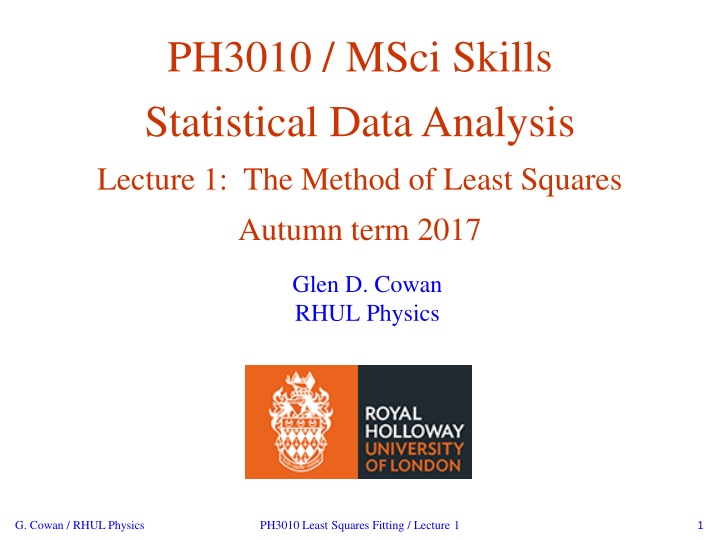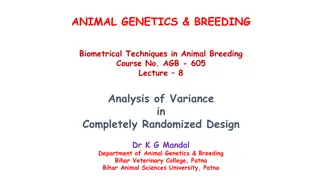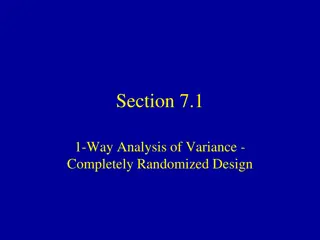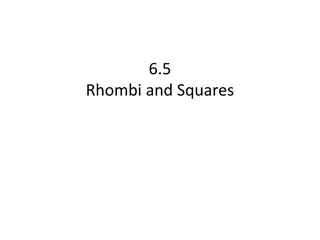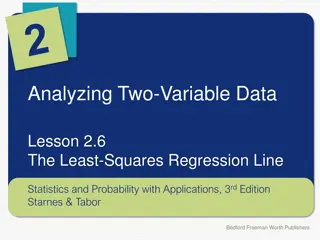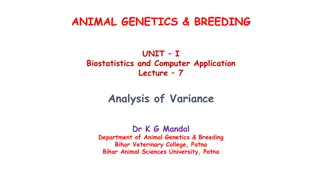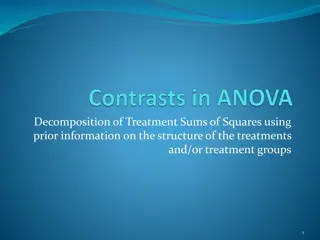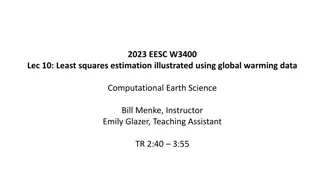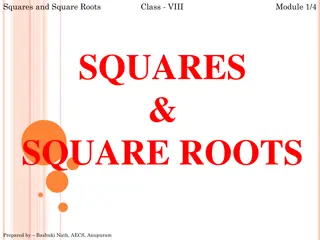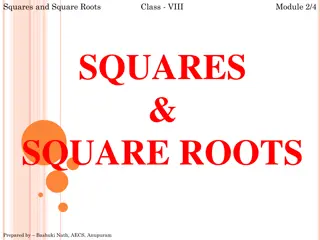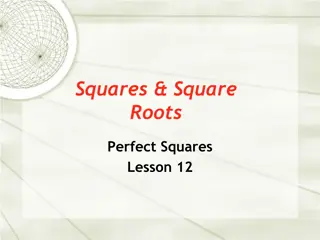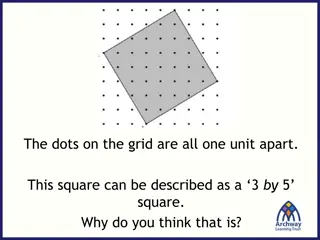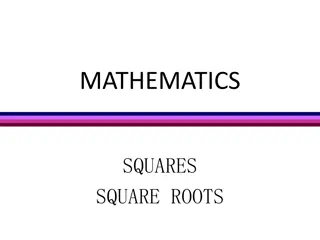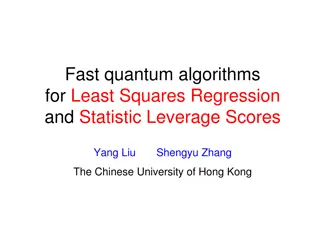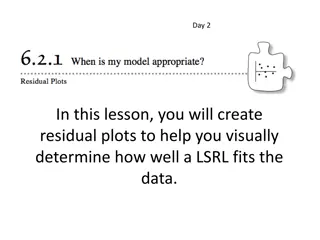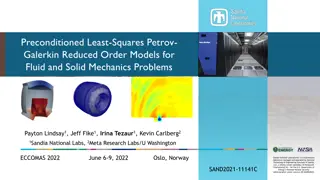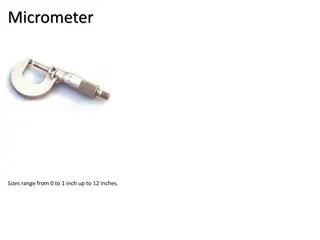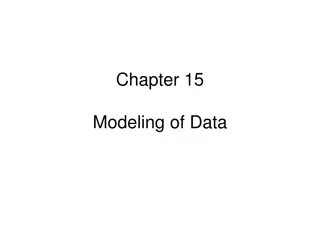Statistical Data Analysis: The Method of Least Squares
This module on Statistical Data Analysis covers curve fitting using the method of least squares and an introduction to Machine Learning. Students will learn how to find fitted parameters, statistical errors, and conduct error propagation. The goal is to accurately fit a curve to measured data points, considering the uncertainties in the measurements. Exercises include writing a mini-project report and submitting code appendices. The course will progress to discussing goodness-of-fit, fitting correlated data, and more advanced exercises in the following weeks.
Download Presentation

Please find below an Image/Link to download the presentation.
The content on the website is provided AS IS for your information and personal use only. It may not be sold, licensed, or shared on other websites without obtaining consent from the author.If you encounter any issues during the download, it is possible that the publisher has removed the file from their server.
You are allowed to download the files provided on this website for personal or commercial use, subject to the condition that they are used lawfully. All files are the property of their respective owners.
The content on the website is provided AS IS for your information and personal use only. It may not be sold, licensed, or shared on other websites without obtaining consent from the author.
E N D
Presentation Transcript
PH3010 / MSci Skills Statistical Data Analysis Lecture 1: The Method of Least Squares Autumn term 2017 Glen D. Cowan RHUL Physics G. Cowan / RHUL Physics PH3010 Least Squares Fitting / Lecture 1 1
The Statistical Data Analysis Module This module on Statistical Data Analysis contains two parts: Curve fitting with the method of least squares (weeks 1, 2) Introduction to Machine Learning (week 3) You will be given a number of exercises that should be written up in the form of a mini-project report. The standard rules apply: Use the LaTeX template from the PH3010 moodle page. Word limit is 3000, not including appendices. All code should be submitted as an appendix. The exercises for the least-squares part of the module are at the end of the script on moodle. Core exercises are numbers 1, 2, 3. There may be some adjustment of the assigned exercises depending on how fast we are able to get through the material. (Exercise 4 may become optional.) G. Cowan / RHUL Physics PH3010 Least Squares Fitting / Lecture 1 2
Outline (part 1) Today: Basic ideas of fitting a curve to data The method of least squares Finding the fitted parameters Find the statistical errors of the fitted parameters Using error propagation Start of exercises ----------------------------- Next week: goodness-of-fit, fitting correlated data, more exercises G. Cowan / RHUL Physics PH3010 Least Squares Fitting / Lecture 1 3
Curve fitting: the basic problem Suppose we have a set of N measured values yi, i = 1,.., N. Each yihas an error bar i, and is measured at a value xi of a control variable x known with negligible uncertainty: Roughly speaking, the goal is to find a curve that passes close to the data points, called curve fitting . G. Cowan / RHUL Physics PH3010 Least Squares Fitting / Lecture 1 4
Measured values random variables We will regard the measured yi as independent observations of random variables (r.v.s). Idea of an r.v.: imagine making repeated observations of the same yi , and put these in a histogram: The distribution of yi has a mean iand standard deviation i. We only know the data values yi from a single measurement, i.e., we do not know the i (goal is to estimate this). yi = measured value xi = control variable value i= true value (unknown) i= error bar suppose these are known G. Cowan / RHUL Physics PH3010 Least Squares Fitting / Lecture 1 5
Fitting a curve The standard deviation i reflects the reproducibility (statistical error) of the measurement yi. If i were to be very small, we can imagine that yi would we be very close to its mean i, and lie on a smooth curve given by some function of the control variable, i.e., i = f(xi). Goal is to find the function f(x). Here we will assume that we have some hypothesis for its functional form, but that it contains some unknown constants (parameters), e.g., a straight line: vector of parameters Curve fitting is thus reduced to estimating the parameters. G. Cowan / RHUL Physics PH3010 Least Squares Fitting / Lecture 1 6
Least Squares: main idea Consider fitting a straight line ad suppose we pick an arbitrary point in parameter space ( 0, 1), which gives a certain curve: Here the curve does not describe the data very well, as can be seen by the large values for the residuals: residual of ith point = G. Cowan / RHUL Physics PH3010 Least Squares Fitting / Lecture 1 7
Minimising the residuals If a measured value yi has a small i, we want it to be closer to the curve, i.e., measure the distance from point to curve in units of i: normalized residual of ith point = Idea of the method of Least Squares is to choose the parameters that give the minimum of the sum of squared normalized residuals, i.e., we should minimize the chi-squared : G. Cowan / RHUL Physics PH3010 Least Squares Fitting / Lecture 1 8
Least squares estimators The values that minimize 2( ) are called the least-squares estimators for the parameters, written with hats: The fitted curve is thus best in the least-squares sense: G. Cowan / RHUL Physics PH3010 Least Squares Fitting / Lecture 1 9
Comments on LS estimators We can derive the method of Least Squares from a more general principle called the method of Maximum Likelihood applied to the special case where the yi are independent and Gaussian distributed: , It is equally valid to take the minimum of 2( ) as the definition of the least-squares estimators, and in fact there is no general rule for finding estimators for parameters that are optimal in every relevant sense. G. Cowan / RHUL Physics PH3010 Least Squares Fitting / Lecture 1 10
Next steps 1. How do we find the estimators, i.e., how do we minimize 2( )? 2. How do we quantify the statistical uncertainty in the estimated parameters that stems from the random fluctuations in the measurements, and how is this information used in an analysis problem, e.g., using error propagation? 3. How do we assess whether the hypothesized functional form f(x; ) adequately describes the data? G. Cowan / RHUL Physics PH3010 Least Squares Fitting / Lecture 1 11
Finding estimators in closed form For a limited class of problem it is possible to find the estimators in closed form. An important example is when the function f(x; ) is linear in the parameters , e.g., a polynomial of order M (note the function does not have to be linear in x): As an example consider a straight line (two parameters): We need to minimize: G. Cowan / RHUL Physics PH3010 Least Squares Fitting / Lecture 1 12
Finding estimators in closed form (2) Set the derivatives of 2( ) with respect to the parameters equal to zero: G. Cowan / RHUL Physics PH3010 Least Squares Fitting / Lecture 1 13
Finding estimators in closed form (3) The equations can be rewritten in matrix form as which has the general form Read off a, b, c, d, e, f, by comparing with eq. above. G. Cowan / RHUL Physics PH3010 Least Squares Fitting / Lecture 1 14
Finding estimators in closed form (4) Recall how to invert a 2 2 matrix: Apply A 1 to both sides of previous eq. to find solution (written with hats, because these are the estimators): G. Cowan / RHUL Physics PH3010 Least Squares Fitting / Lecture 1 15
Comments on solution when f(x;) is linear in the parameters Finding solution requires solving a system of linear equations; can be done with standard matrix methods. Estimators are linear functions of the yi. This is true in general for problems of this type with an arbitrary number of parameters. Even though we could find the solution in closed form, the formulas get a bit complicated. If the fit function f(x; ) is not linear in the parameters, it is not always possible to solve for the estimators in closed form. So for many problems we need to find the solution numerically. G. Cowan / RHUL Physics PH3010 Least Squares Fitting / Lecture 1 16
Finding LS estimators numerically Start at a given point in the parameter space and move around according to some strategy to find the point where 2( ) is a minimum. j For example, alternate minimizing with respect to each component of : minimum starting point Many strategies possible, e.g., steepest descent, conjugate gradients, ... (see Brandt Ch. 10). i Siegmund Brandt, Data Analysis: Statistical and Computational Methods for Scientists and Engineers 4th ed., Springer 2014 G. Cowan / RHUL Physics PH3010 Least Squares Fitting / Lecture 1 17
Fitting the parameters with Python The routine routine curve_fit from scipy.optimize can find LS estimators numerically. To use it you need: We need to define the fit function f(x; ), e.g., a straight line: G. Cowan / RHUL Physics PH3010 Least Squares Fitting / Lecture 1 18
Fitting the parameters with Python (2) The data values (xi, yi, i) need to be in the form of NumPy arrays, e.g, Start values of the parameters can be specified: To find the parameter values that minimize 2( ), call curve_fit: Returns estimators and covariance matrix as NumPy arrays. Need absolute_sigma=True for the fit errors (cov. matrix) to have desired interpretation. G. Cowan / RHUL Physics PH3010 Least Squares Fitting / Lecture 1 19
Statistical errors of fitted parameters The estimators have statistical errors that are due to the random nature of the measured data (the yi). If we were to obtain a new independent set of measured values, y1,..., yN, then these would in general give different values for the estimated parameters. We can simulate the data set y1,..., yN many times with the Monte Carlo method. For each set evaluate the estimators for 0 and 1 from the straight-line fit and enter into a scatter plot: G. Cowan / RHUL Physics PH3010 Least Squares Fitting / Lecture 1 20
Statistical errors of fitted parameters (2) ^ ^ Project points onto the 0 and 1 axes: Each distribution s standard deviation (~width) is used as a measure of the corresponding estimator s statistical error. G. Cowan / RHUL Physics PH3010 Least Squares Fitting / Lecture 1 21
(Co)variance, correlation ^ ^ The scatter plot of 0 versus 1 showed that if one estimate came out high, the other tended to be low and vice versa. This indicates that the estimators are (negatively) correlated. To quantify the degree of correlation in any two random variables u and v we define the covariance, The covariance of a variable u with itself is its variance V[u] = u2 The square root of the variance = standard deviation u. Also define dimensionless correlation coefficient (can show 1 1): G. Cowan / RHUL Physics PH3010 Least Squares Fitting / Lecture 1 22
Covariance etc. from straight-line fit From the simulated values shown in the scatter plot, use standard formulae (see RHUL Physics formula book) to obtain the standard deviations and covariance: G. Cowan / RHUL Physics PH3010 Least Squares Fitting / Lecture 1 23
Covariance matrix If we have a set of estimators we can find the covariance for each pair and put into a matrix Covariance matrix is square and symmetric. Diagonal elements are the variances: The vector of estimators and their covariance matrix are the two objects returned by the routine curve_fit: G. Cowan / RHUL Physics PH3010 Least Squares Fitting / Lecture 1 24
Covariance from derivatives of 2() It is also possible to obtain the covariance matrix from second derivatives of 2( ) with respect to the parameters at its minimum. First find U 1, and then invert to find the covariance matrix U. This is what curve_fit does (derivatives computed numerically). Example with straight-line fit gives: G. Cowan / RHUL Physics PH3010 Least Squares Fitting / Lecture 1 25
Using the covariance matrix: error propagation Suppose we ve done a fit for parameters ( 1,..., m) and obtained estimators and their covariance matrix. We may then be interested in a given function of the fitted parameters, e.g., What is the standard deviation of the quantity u? That is, how do we propagate the statistical errors in the estimated parameters through to u? Or suppose we have two functions u and v. What is are their standard deviations and what is their covariance cov[u,v]? G. Cowan / RHUL Physics PH3010 Least Squares Fitting / Lecture 1 26
The error propagation formulae By expanding the functions to first order about the parameter estimates, one can show that the covariance is approximately and thus the variance for a single function is In the special case where the covariance matrix is diagonal, Uij = i j ij, we can carry out one of the sums to find G. Cowan / RHUL Physics PH3010 Least Squares Fitting / Lecture 1 27
Comments on error propagation In general the estimators from a fit are correlated, so their full covariance matrix must be used for error propagation. The approximation of error propagation is that the functions are linear in a region of plus-or-minus one standard deviation about the estimators. Simple example: G. Cowan / RHUL Physics PH3010 Least Squares Fitting / Lecture 1 28
Exercise 1: polynomial fit G. Cowan / RHUL Physics PH3010 Least Squares Fitting / Lecture 1 29
Polynomial fit: error band G. Cowan / RHUL Physics PH3010 Least Squares Fitting / Lecture 1 30
Polynomial fit: error propagation Consider the difference between the fitted curve values at x = a and x = b: Use error propagation to find the standard deviation of ab (see script). G. Cowan / RHUL Physics PH3010 Least Squares Fitting / Lecture 1 31
Ball and ramp data from Galileo Galileo Galilei, Manuscript f.116, Biblioteca Nazionale Centrale di Firenze, bncf.firenze.sbn.it In 1608 Galileo carried out experiments rolling a ball down an inclined ramp to investigate the trajectory of falling objects. G. Cowan / RHUL Physics 32
Ball and ramp data from Galileo Units in punti (approx. 1 mm) Suppose h is set with negligible uncertainty, and d is measured with an uncertainty = 15 punti. G. Cowan / RHUL Physics PH3010 Least Squares Fitting / Lecture 1 33
Analysis of ball and ramp data What is the correct law that relates d and h? Try different hypotheses: For now, fit the parameters and , find their standard deviations and covariance. Next week we will discuss how to test whether a given hypothesized function is in good or bad agreement with the data. G. Cowan / RHUL Physics PH3010 Least Squares Fitting / Lecture 1 34
Extra slides G. Cowan / RHUL Physics PH3010 Least Squares Fitting / Lecture 1 35
History Least Squares fitting also called regression F. Galton, Regression towards mediocrity in hereditary stature, The Journal of the Anthropological Institute of Great Britain and Ireland. 15: 246 263 (1886). Developed earlier by Laplace and Gauss: C.F. Gauss, Theoria Motus Corporum Coelestium in Sectionibus Conicis Solem Ambentium, Hamburgi Sumtibus Frid. Perthes et H. Besser Liber II, Sectio II (1809); C.F. Gauss, Theoria Combinationis Observationum Erroribus Minimis Obnoxiae, pars prior (15.2.1821) et pars posterior (2.2.1823), Commentationes Societatis Regiae Scientiarium Gottingensis Recectiores Vol. V (MDCCCXXIII). G. Cowan / RHUL Physics PH3010 Least Squares Fitting / Lecture 1 36
